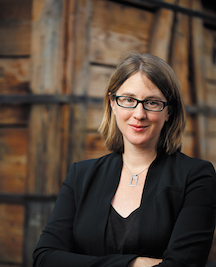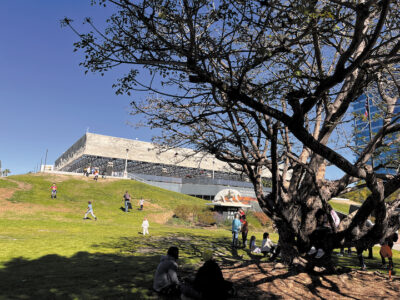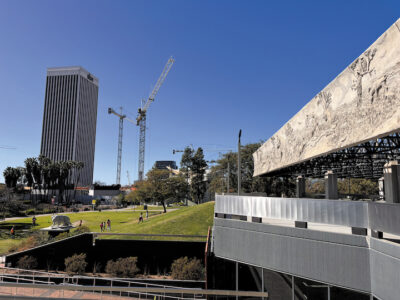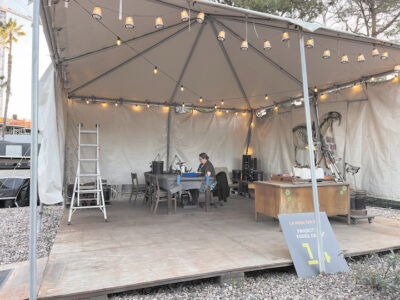Science and community come together at La Brea Tar Pits

PRESTIGIOUS distinction was awarded to Dr. Lori Bettison-Varga.

DR. EMILY LINDSEY
There’s a lot going on at the La Brea Tar Pits.
We recently talked with Dr. Emily Lindsey, associate curator and excavation site director at the La Brea Tar Pits and Museum. Said Lindsey, “Because of its location, [the site] really has the power to bring its story to millions of people. We can take a world-class fossil site and actually share both the science of the site, and also the process of that scientific enterprise, with the public at a scale that is hard to do anywhere else.”
Lindsey told us, “We have an incredible, once-in-a-lifetime opportunity to start demystifying [the scientific] process and to help people understand how it’s done, how it relates to their daily life — or to things that they do in their daily life — and why science is a trustable endeavor; why it is a trustable way of getting information that allows us to make valuable, reliable predictions about the future.”
As noted, news and planning activity are emanating from the Tar Pits on a regular basis.
President and Director of the Natural History Museums of Los Angeles County Dr. Lori Bettison-Varga recently was named a 2022 Fellow of the American Association for the Advancement of Science (AAAS). Recognition by the AAAS is one of the most prestigious distinctions that can be bestowed upon a scientist. Bettison-Varga is also helming an expansion of the La Brea Tar Pits and Museum. Architectural firm Weiss/Manfredi was chosen to lead the conceptual design of the project. The firm was selected because of its approach to unifying the many parts of the 13-acre site, which includes the park, the George C. Page Building, the excavation pits and the Lake Pit.
The design firm chosen to focus on the interior of the museum — on storytelling and exhibit designs — is Kossmanndejong.

FIELD TRIP kids playing and rolling on the grass outside the George C. Page Building.
In a beautiful video produced by Weiss/Manfredi on the La Brea Tar Pits website, (tarpits.org/transformation), people can glimpse a vision for a museum “20 million years in the making… a living museum for a community.”

TO BE PRESERVED and restored as part of reimagining the La Brea Tar Pits campus is the 10-foot-high, four-sided fiberglass frieze of Ice Age landscapes, plants, and mammals that was created in 1977 by sculptor Manuel Paz.

THE PARK in Hancock Park that adjoins the Tar Pits Museum is popular with families.
The planned design will expand visitors’ ability to observe the scientific research that happens daily at La Brea Tar Pits. There will be a shaded outdoor classroom, improved excavation visibility and a new public terrace that will provide a view from the rooftop. A new exhibition building will be built and will include a theater, a multipurpose room and more exhibition space. A restaurant will also be included in the renovation.
As residents know, the open green space the Tar Pits now have is a wonderful place for families to enjoy time outside. Kids have long loved rolling down the big green hill. Kids on field trips, youth sports groups and picnickers take advantage of the fields. Couples, families and joggers enjoy the path around the park.
Museum leaders and Weiss/Manfredi see this existing space as a vital part of the community and the museum area. Plans will preserve the grassy slopes and enhance the recreation areas while incorporating climate-appropriate native plants.
More shade will be provided by canopies and entry plazas and a pedestrian walkway will loop through the site taking visitors on a “journey from prehistoric time to today,” as the website states.
Through the redesign, the team hopes to expand on the site’s ability to teach people about the science of the past, the science of climate change and global change, extinction, survival and also the scientific process in general.
The site is home to a vast quantity and variety of fossils, and the time period the site covers is the past 60 thousand years. Because of this, paleontologists are able to actually document the kinds of changes that happened in response to climate changes, like warming and droughts, to human arrival on the landscape and the loss by extinction of about two-thirds of the large mammals from the terrestrial ecosystem, which happened in a very short time and was the biggest extinction event since that of the dinosaurs.

LONE SCIENTIST is hard at work in view of park visitors to the La Brea Tar Pits.
Scientists at the site are now partnering with local organizations involved in policy and land management. The Nature Conservancy, the City of Los Angeles and its Department of Recreation and Parks are interested in information garnered from fossil records that can help inform conservation planning in and around the Los Angeles area today. “We look for what characteristics make a species resilient in the face of dramatic changes. Knowing this can help inform restoration efforts,” said Lindsey.
She told us she believes that now, more than ever, what is being done at the Tar Pits is important. “We’ve just gone through this very difficult several-year period where it’s become very clear that there is a lot of distrust of science and scientists and a lot of misunderstanding of what science is — what scientific methodology entails.”
Lindsey concluded that she is excited to be involved in the redesign and expansion and in helping make the scientific process more accessible to, and understandable for, the public.
Category: People
